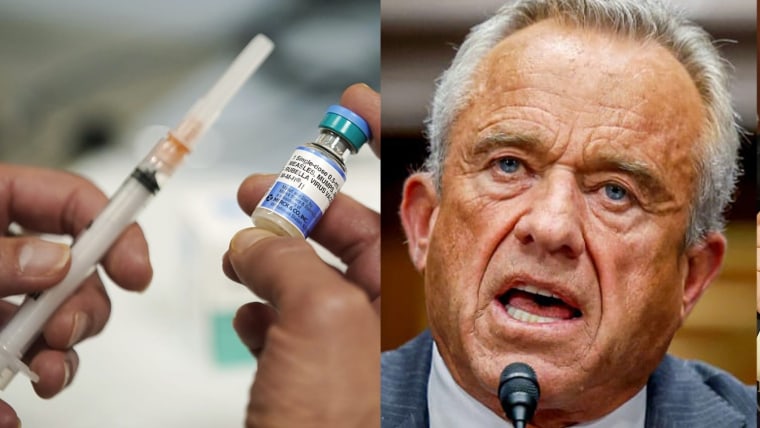My daily work as an oncologist is often sobering and difficult. From diagnosis to treatment, cancer journeys can be fraught with uncertainty and emotional turmoil. But I find hope through the steely resolve of my patients and in the boundless promise of ongoing cancer research.
While my patients remain as intrepid as ever, this vital research now stands to be choked off by the Trump administration’s budget cuts at the National Institutes of Health (NIH), including termination of existing grants at universities and mass layoffs. The White House went even further in its budget proposal released Friday, calling for NIH's funding to be cut from $48 billion to $27 billion.
The NIH is the largest funder of cancer research in the United States, providing roughly $8 billion annually that flows down to universities, medical centers and other grant recipients. Furthermore, the Republican-led Congress is set to take a scythe to several parts of the Congressionally Directed Medical Research Programs (CDMRP) that support work on many crucial types of cancers, including those of the pancreas, lungs and kidneys.
For decades, presidential administrations have made a cure for cancer part of their ambitions, and their goals have had bipartisan support.
“A lot of the basic science and pathways we identify, things to study, come from academic labs,” says Dr. Suneel Kamath, an oncologist at Cleveland Clinic. “Whatever pharma will eventually make drugs for through drug development, a lot of the initial targets will be found in university settings. So we will fall behind on those things.”
For decades, presidential administrations have made a cure for cancer part of their ambitions, and their goals have had bipartisan support. Richard Nixon declared a “war on cancer” by signing the National Cancer Act into law Dec. 23, 1971. It infused nearly $1.6 billion in federal funding to cancer research over three years. Forty-five years later, under President Barack Obama, then-Vice President Joe Biden launched the multibillion-dollar Cancer Moonshot project, which centralized research as the means to achieve a decade of cancer progress in just five years. And in 2024, when Donald Trump accepted the Republican nomination, he pledged that he would “get the cure to cancer, Alzheimer’s, and so many other things.”
Amid years of federal investments in the NIH and the National Cancer Institute, cancer death rates declined 34% from 1991 to 2022 — roughly 4.5 million fewer deaths, thanks partly to advances in cancer screening and prevention efforts.

But the disease remains a national problem. Almost 40% of people will be diagnosed with the malady in their lifetimes. As many as 2 million new cases are expected to be diagnosed in 2025 alone, with a notable uptick in populations under 50 years old.
The administration’s assault on cancer research is part of a larger effort by the Department of Government Efficiency to trim the fat on federal programs. As Dr. Atul Gawande, a surgeon and former official at USAID, wrote in the New Yorker, “existing flaws and challenges across this infrastructure deserve attention and reform. But taking a chainsaw to it will only produce more waste, less output, and poorer results.” Research focused on improving early detection and prevention of cancers inevitably saves the government money, as early stage diseases are two to four times cheaper to treat than those diagnosed at a later stage.
Firings at the NIH Clinical Center, the country’s biggest research hospital, have already devastated highly promising research work.
Instead, the Trump administration proposed cutting and capping NIH’s payments for “indirect” costs (rent, electricity, specialized lab equipment, support personnel, etc.) at 15%. These facility and administrative fees associated with research can range from anywhere between 10% to 80% of a grant and are negotiated between the NIH and individual institutions.
But since no two cancer centers are ever alike in their “indirect” costs that quite literally keep the lights turned on, a uniform, fixed cap would disrupt or halt operations for many. “It is a little bit naive on their part to say, ‘We are not touching the funding for the actual research; it’s only for the indirect costs.’ But it’s really one and the same,” Kamath says.
For now, that particular plan is blocked by court injunction. But job cuts across the federal health workforce have already had palpable effects. Firings at the NIH Clinical Center, the country’s biggest research hospital, have already devastated highly promising research work that aims to use the body’s own immune cells to combat gastrointestinal cancers. Patients’ experimental treatments have already been delayed because of limited staff capacity to make these personalized cell therapies and purchasing stalls. These therapies represent potential lifelines for those with advanced cancers that have not responded to standard drugs. And many of these individuals, who are now increasingly younger in age, cannot afford to wait.

Elsewhere, hiring freezes at the National Institute for Occupational Safety and Health have scuppered work studying elevated cancer rates in firefighters and paused a clinical trial of a new drug for advanced head and neck cancers. Research grants for Columbia University’s cancer center have been canceled because of student-led Gaza protests. Concerns around “wokeness” have ended funding for studies examining cancers in sexual and gender minority individuals — an understudied group with poor cancer outcomes — at various academic institutions such as Emory University and the Mayo Clinic.
Countless Americans depend on the continued progress of cancer research to save lives and improve cancer care. And without it, many potential insights and treatments needed to propel oncology forward will never be realized. As Gawande wrote, “For the sake of political control, the Administration is jeopardizing an enterprise that added decades to life expectancy in the United States and made America the world leader in technology and innovation.”
The progress of cancer research is rarely linear. While most ideas fail, some will lead to seismic breakthroughs. Adding widespread budget cuts to this already difficult scientific process will not only dissuade future scientists from entering the country’s labs, but will also unconscionably swing the pendulum from life to death for many hopeful patients.
